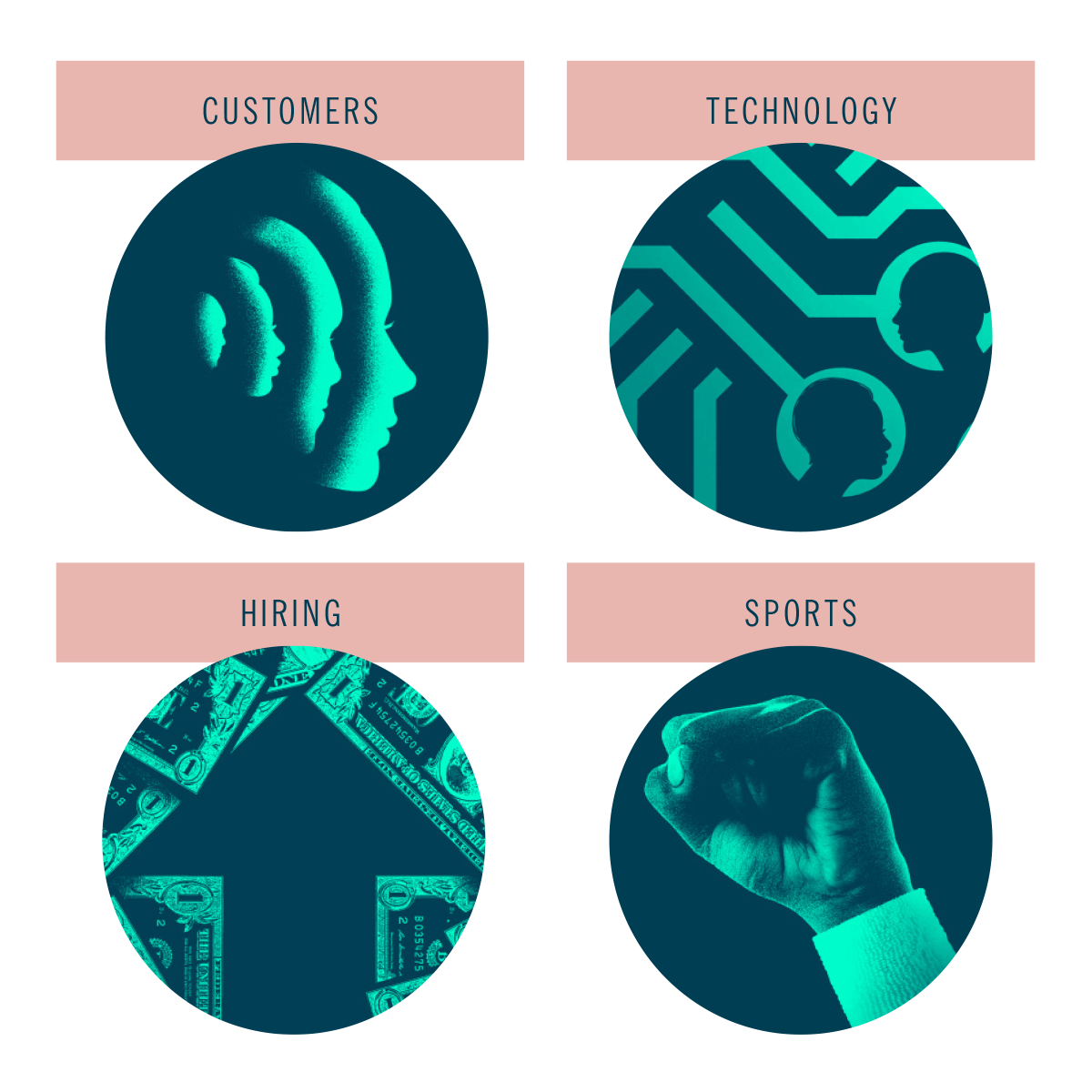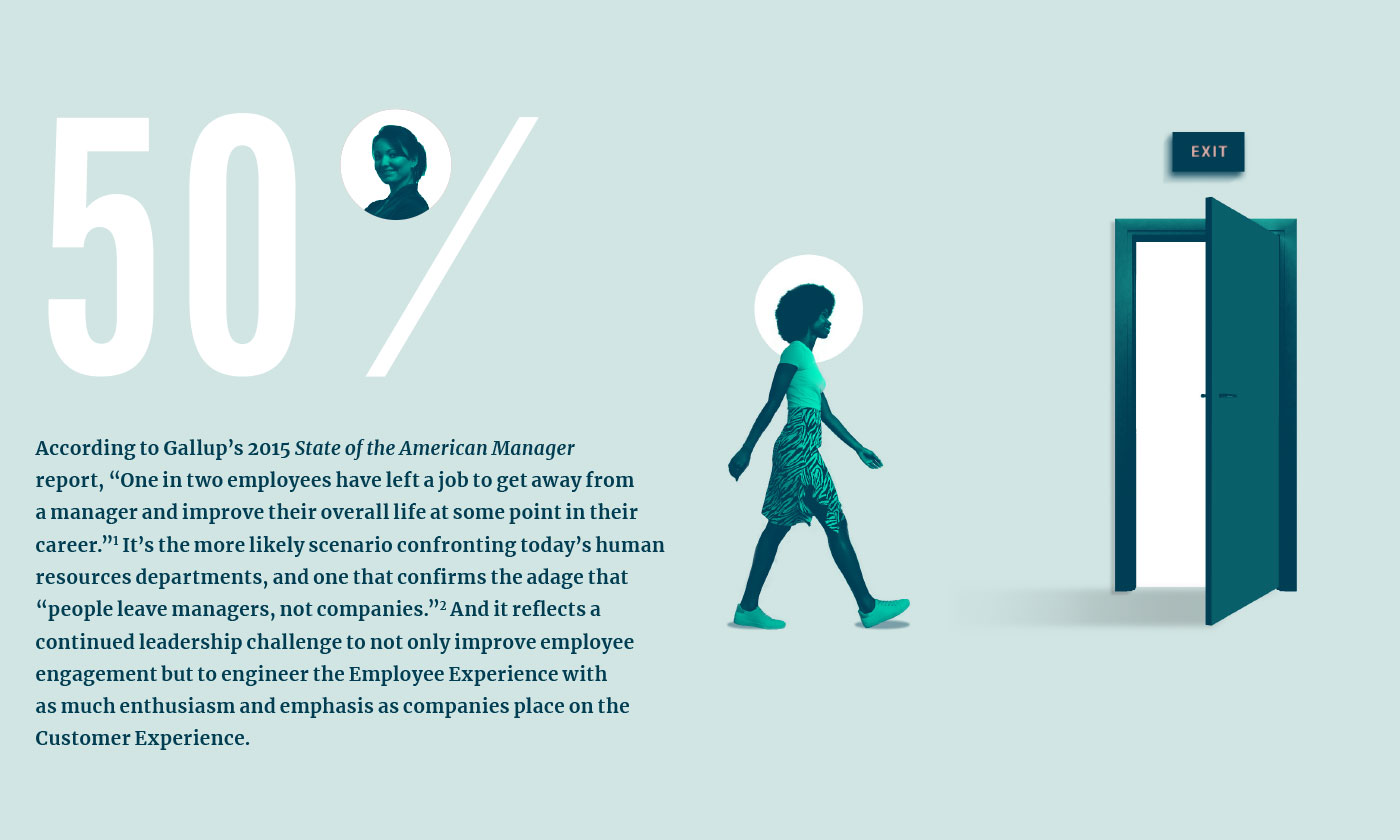TThe Great Resignation. The Big Quit. The Great Shift.
Regardless of the phrase used to label it, the dramatic workforce upheaval in today’s economy has been a growing problem for decades. Only now, though, in light of the COVID-19 pandemic and other demographic changes like the high number of retiring Baby Boomers, has it received so much attention.
But why have some companies and industries historically been impacted by high employee turnover while others have thrived? While many reasons come to mind, including low wages, being recruited by another company, in-office work requirements, and lack of work-life balance, the real answer lies in a company’s ability to attract, retain, and exit employees. By effectively addressing these three areas — regardless of the state of the industry or the economy — managers can move employees from a state of disengagement to reengagement, improve productivity and happiness, create stronger employee-employer relationships built on trust and loyalty, and enrich the company’s brand and culture. This will lead to reduced employee turnover and help the company thrive in this new era.
Many employers have rightfully sensed that this change in the job market and employer-employee “contract” is here to stay. Unfortunately, they haven’t responded to the “disruption” aggressively enough to minimize its impact. And without a robust response, the disruption will only get worse. A company can’t do much to retain employees who have attained wealth through real estate or the stock market and are exiting the labor force completely. Those employees represent a small percentage of the overall workforce. But it can do a lot to mitigate employee losses due to other reasons.
So, how do you win the war for talent in today’s worker-friendly environment? By systemically rethinking the entire human capital equation (see below). To understand exactly how Jabian’s Healthy Human Capital Equation (HxCx) works, let’s break down each component and outline some best practices managers can follow to improve each area.
Enhanced
Recruitment
2X Better
Retention
Attrition Best
Practices
HEALTHY HUMAN CAPITAL (HxCx)
•••
2X Better Retention
Better retention is doubled in the equation for several reasons. First, if your company is a revolving door, it doesn’t matter how good you are at recruitment. Second, your current talent is the best source for your future talent — success breeds success. And third, you need to de-average your retention by understanding your employees’ needs and carefully crafting policies that are aligned and not “one size fits all.” In essence, treat your employees like you would treat your best customers.
While all retention is important, there are some positions/players that are more instrumental to your overall value proposition than others. What drives the creativity in your company? Where is the energy located? Who is at the forefront of your company culture? Where is the inspiration located? We are not talking about senior executives here — we are talking about the “get it done” and “create something from nothing” human capital in your organization. Those employees are three layers deep. Don’t know who they are? Now is the time to find out.
Most companies say the right thing when it comes to retention. But for those leaders who are serious about improving it, what do they need to do better and faster to make an impact? Here are some proven methods to improve retention.
Eliminate Toxic Management Practices
As noted above, employees more often leave bad managers than bad companies. This means it’s important to assess your managers on their ability to create the culture and environment that you want. This isn’t as simple as focusing on the managers with high turnover, as turnover isn’t always directly correlated with management quality. The focus needs to be on the practices and methods that your managers employ.
Employee surveys and 1:1 discussions are the most effective ways to determine where additional management support (coaching, retraining, and removal) needs to occur. The surveys will help you to identify and target potential quality issues, while the 1:1 meetings will allow you to reach the next level of detail and “double-click” on the problem. Keep in mind that good, actionable feedback requires a high degree of employee trust. If trust is low, your results will be skewed.
Companies should also make management training available to improve relationships, leadership, and retention practices using in-person and self-service delivery formats. And finally, don’t penalize managers for accessing the training. The first step managers need to take to improve their management style is to acknowledge that they can improve and become more effective.
Move to Matrixed Team Accountability
Where possible, move from a command-and-control structure to a matrixed, team accountability model. Well executed Matrix Operating Models build stronger leaders and professionals throughout the organization as employees today don’t mind sharing the credit, but they don’t want to be singled out when things go wrong. It also makes sense considering that it’s nearly impossible for any single person in today’s large organizations to be 100 percent responsible given the siloes and distributed authority methods that companies employ. Finally, teams are better at nurturing and supporting each other and flexing to “pick up the slack” during times of high workload and peak stress.
Change Your Meeting Culture
One way you can enhance your employee experience while simultaneously increasing productivity is to address your company’s “meeting culture.” Some of the questions you should be asking include:
- How much time do your value creators spend in meetings?
- How many people are in each meeting?
- How long is each meeting?
- How much of a meeting is spent sharing information that is better shared in an email?
- How much information is shared in detail that should have been summarized?
In general, most employees spend too much time in meetings, with too many people, for too long each time, with limited purpose and few outcomes. Some best practices that should be considered when changing your meeting culture include:
- When should we meet? When we are ready for a decision to be made.
- How much time do your value creators spend in meetings? 20 percent or less per week.
- How many people are in each meeting? No more than necessary to make the decision
- How long is each meeting? Just long enough to make a decision
- How much of a meeting is spent sharing information that is better shared in an email? Less than 20 percent of a meeting should be spent summarizing and communicating information that has already been shared via another format.
- How much information is shared in detail that should have been summarized? None.
As your managers and executives learn to adapt to a more productive way of meeting, one way to get started is to:
- Immediately cut the duration of every meeting by one-third + five minutes. Short timeframes create a sense of urgency and help meetings stay on topic:
- – 90-minute meetings become 55-minute meetings
- – 60-minute meetings become 35-minute meetings
- – 30-minute meetings become 15-minute meetings
- Insist that all meeting invites include a purpose statement in the invite with an agenda:
- – What decision needs to be made?
- – Summary of supporting information
- – Link to detailed information
- – List of subordinates or other teams/team members that have been consulted
- – Who are the decision-makers?
- – Other roles according to a RACI or other structure (Responsible, Accountable, Consulted, Informed)
- Provide cover for employees to decline or exit meetings that aren’t following the suggested script
- Publish meeting notes with follow-up items and assignments to keep the group focused
Eliminating the “dead time” that employees spend at work when they should be focusing on more value-added activities, or activities outside of work, is one of the most important things you can do to improve the employee experience.
Ensure a Culture of Engagement
Is there alignment between what your leaders say is important versus what is rewarded throughout the organization? A culture of engagement starts at the top and begins when leaders establish a framework of behavioral norms and consistent messaging that articulate, reinforce, and reward the desired culture. Understanding the Engagement Drivers and Levers that are available to impact them (see Jabian Engagement Framework) is a key effort organizations need to undertake if they want to improve their Human Capital Experience (HxCx).
Address Outdated Compensation Practices
For too long, companies have been paying as little as possible to recruit and retain valued employees. The problem with this approach, however, is that when talent markets readjust, companies are fighting today’s battles with yesterday’s tools. The only way to maintain competitiveness in compensation is to always pay what a position is worth, regardless of whether the employee would have stayed for less. Try to adjust employee compensation as the market adjusts before an employee marches into your office. If employees are asking you to adjust their compensation, they are probably already looking externally. And if you aren’t sure where their compensation should be, you are likely aiming too low.
Thanks to remote work, talent is no longer confined to your specific city or region. This geographic expansion greatly increases the pool of job opportunities for your talented employees. Additionally, as the high-tech and software industries have continued to grow double digits year in and year out, their need for talent has stayed very strong. Your company, regardless of industry, needs to be looking at how similar talent is compensated in the software industry. And don’t just look at similar job titles. A lot of employees are starting to re-tool their skills in data, analytics, and artificial intelligence. As they do, the HR analyst that you think is happy can now look to people analytics opportunities at other companies. If they upskill enough, they can look at analytics roles outside of their current domain as well. To retain your best employees, you not only have to compensate them for what they are doing now but what they “could” do within six months if they started getting certifications.
Finally, how should you approach your employees’ stock options, equity, and other enhanced compensation? As noted, not all attrition is equal. The days of a CEO making 300 times the average employee are over. As you look toward your company’s future profitability, how do you retain the engine that is going to build, drive, and sustain those profits? Do you honestly think that your combined data science team (total compensation) is worth less than one person? Depending on the company, a strong argument could be made that a large percentage of employees deserve equity or enhanced compensation. Certainly, employees who contribute to creating new products and services, attracting and retaining customers, and enhancing the company’s value proposition should be important for you to consider locking in from an equity or enhanced compensation perspective. If you want to remain viable as business models shift to analytics, AI, and other technologies, equity and enhanced compensation need to move beyond the executive suite.
Expand Flexible Paid Time Off and Family Leave Benefits
Review and reevaluate your company’s paid time off and family leave benefits. When “life gets in the way” for employees, do your policies reflect encouragement and support, or create one more reason to leave? If you combine expanded and enhanced flexibility and benefits with a move to team and matrixed-based responsibilities, you will find that teams cover for each other when “life gets in the way” and that productivity will increase. It is beyond time for companies to focus on the results that are achieved instead of the hours worked and days taken off. As one small example, companies moving to a four-day workweek have achieved productivity improvements despite the reduction of hours.3

Offer Remote Work
As the pandemic continues, it is interesting to see some companies adjusting to permanent remote work while other companies require part- to full-time in-office work. At times, the decision a company makes seems to be driven by the personality and preference of its leaders rather than by work requirements. Don’t let your company be one of them. Allow remote work whenever and however you can, for as many positions as possible. When you must have an employee be in person, make the reasoning crystal clear. Allow employees to challenge in-person work to make sure that the decision is rational and logical and based on evidence. Employees who prefer remote work who are forced to be in person for illogical and flimsy reasoning will find work elsewhere.
Address Sustainability and Diversity, Equity & Inclusion
Perhaps this goes without saying, but there are many reasons to become sustainable and address diversity, equity, and inclusion beyond talent retention. We won’t belabor the point, but you simply must have sustainability and DEI commitments to be relevant in today’s talent wars — and you must keep them. We talk a lot about DEI in other articles, including:

Conduct Reinforcement Interviews
At the end of the employee’s first year, do you ask for feedback? Not a performance review, but honest feedback on policies, their career, and if the company can do anything to further support them in their success. Ask them if the job description reflects the work that they are actually doing. Do they need training? Better tools to do the job? Do you routinely have skip-level meetings to gain additional insights? Increasing the level of communication, trust through actions, and genuine support will generate loyalty and make the employee think twice before leaving.
Authentically Demonstrate a Purpose Beyond Profit
How does your firm make the world a better place? Are you expanding access by providing a substantial service at a cost below what others can do? Are you leveraging your profitable lines of business to provide products at cost in poorer areas of the world? Businesses are not intended to be not-for-profits, nor should they be expected to play the role of governments, but your business should have a social contract that is meaningful to its mission and vision, and that resonates with the majority of employees.
•••
Attrition Best Practices
How well do you keep track of your alumni? Are you proud of them and their accomplishments? Do you celebrate their successes and interact with them regularly? Every person who has ever been a part of your company is a walking billboard for your brand. What do they say about you when you aren’t watching — or when you are watching, for that matter?
It is time for companies to rethink attrition and to focus on the lifetime value of their relationships with former employees. How do you do this? Think of voluntarily departing employees much like colleges and universities think of their graduates. These are cherished alumni with whom the schools desire to maintain a relationship. So how then do you develop and maintain that healthy relationship with your departed talent?
Conduct Final Interviews with the Future in Mind
Instead of a traditional “exit interview,” continue to build trust by conducting a final interview aimed at gaining an in-depth understanding of why the employee is leaving. How the person is treated in a final interview spreads like wildfire through the various relationships that person has with other employees. If they were treated better than expected, organizational trust goes up. If not, trust goes down. Utilize the Jabian Engagement Framework to get a crystal-clear understanding of why your valued employee is leaving and where your employee engagement pain points lie.

Jabian Engagement Framework
Fall 2016
Think about it this way: You’ve spent a considerable amount of time attracting, hiring, and retaining top talent. Now that they are leaving the organization, why wouldn’t you maintain a good relationship with those former employees in the future? Creating an alumni group or alumni referral program to continue networking and career-building opportunities has many benefits. Not only could you post vacant positions to this group, but some former employees could come back in elevated roles and bring with them both best practices and other talented people.
Manage Your Alumni Network
LinkedIn and other social networks already provide a space where corporate alumni can congregate and communicate. Are you managing yours? Are you providing value and insight to them to keep them interested? Do they know about your good works in the community and your new compensation approach? Have you invited them to apply for new positions?

Hire Them Back
After valued employees leave the company, make them an offer to return. It should be a compelling offer and it should address the reason they left in the first place. If they politely decline, let them know that the offer will remain open and that you’d like to revisit it with them soon. Wish them well. Follow up with a note or a card, and even ask them for a referral if they know of someone who might be a good fit for the position. For any given interaction that you have like this, the percentage of former employees who come back may be increased. But if you implement this policy and maintain it over time, it will be an important part of how your company is perceived in the job market.
•••
Enhanced Recruitment
Many companies have reacted to the talent shortage with the standard response — hiring more talent acquisition (TA) professionals or retaining outside TA consultants. These reactions are insufficient solutions. Until you’ve created a new human capital experience, your recruitment challenges will remain. However, there are additional tactics you should take as you integrate the new HxCx into your organization and your recruiting practices.
Weave Your HxCx Messaging Into Your Outreach Activities
As you take the outlined steps to address retention, weave those messages into your communications with potential new hires. Team-based jobs, increased flexibility, an expanded view of compensation, and improved management styles are all important considerations for the talent pools you are tapping.
Compensate Based Upon Company Role, Not Historical Pay
Decide what the role you are hiring for is worth, and then pay for that role. You don’t even need to ask candidates what they are currently making. Change your mindset from “what is the minimum we need to pay to get this person?” to paying what the role is worth. Companies do a good job of understanding their actual margins based on existing expenses, but they have difficulty in seeing the lost potential when they don’t hire fast enough. What would your company look like if product X got out into the market before the competitor’s product? (It didn’t because you lost out on new hires in engineering and product management, which delayed things by three months.) This doesn’t hold true for all roles, but understanding the opportunity cost of not hiring with urgency might help you see that squeezing that last $10,000 out of a recruit just isn’t worth it.
Widen the Definition of Your Competitors in the Job Market
As you establish competitive salary benchmarks for various roles, widen the definition of the role to consider what the role would pay in the software (and other tech) industries. Since any candidate or employee is only six to 12 months away from analytics certification from any number of training providers, you should consider what the compensation would be for the position if it includes the role plus analytics.
Manage the Candidate Experience Just Like a Customer Experience
Much as we are proposing an overhaul to the Human Capital Experience (HxCx), you also need to manage the Candidate Experience. What are your response times? Are you personalizing your responses (not just your emails — are you adapting your recruiting to meet the specific needs of each candidate?)? If you only interview on Fridays, but the candidate only has availability on Thursday, are you adapting? If they ask to speak to someone in product marketing, are you making it happen? Are you following up? Most importantly, are these things measured and reported on?
Nurture Those Who Say No
Without being aggressive, make sure a candidate who turns you down knows that the door is still open. Ask to reengage in the future. Also, ask what you could have done differently. If a candidate was hoping for a product role but in a department that isn’t hiring, let that department know and see if there is any wiggle room. In short, create an alumni network for candidates who haven’t said yes (yet) and keep in touch.
•••
Winning the war for talent requires that a company create an entirely new human capital experience. By managing and cultivating talent through all of its stages (recruitment, tenure/retention, retirement/attrition, re-recruitment, etc.), companies can get, keep, and grow their best talent and continue to thrive in the marketplace. Employees have shown that they are willing to invest in companies that make an effort to create a winning environment. Productivity improvements have been shown to outpace the costs of creating the human capital experience demanded by today’s talent marketplace. And when the new human capital experience becomes part of your culture, it becomes a competitive advantage.

